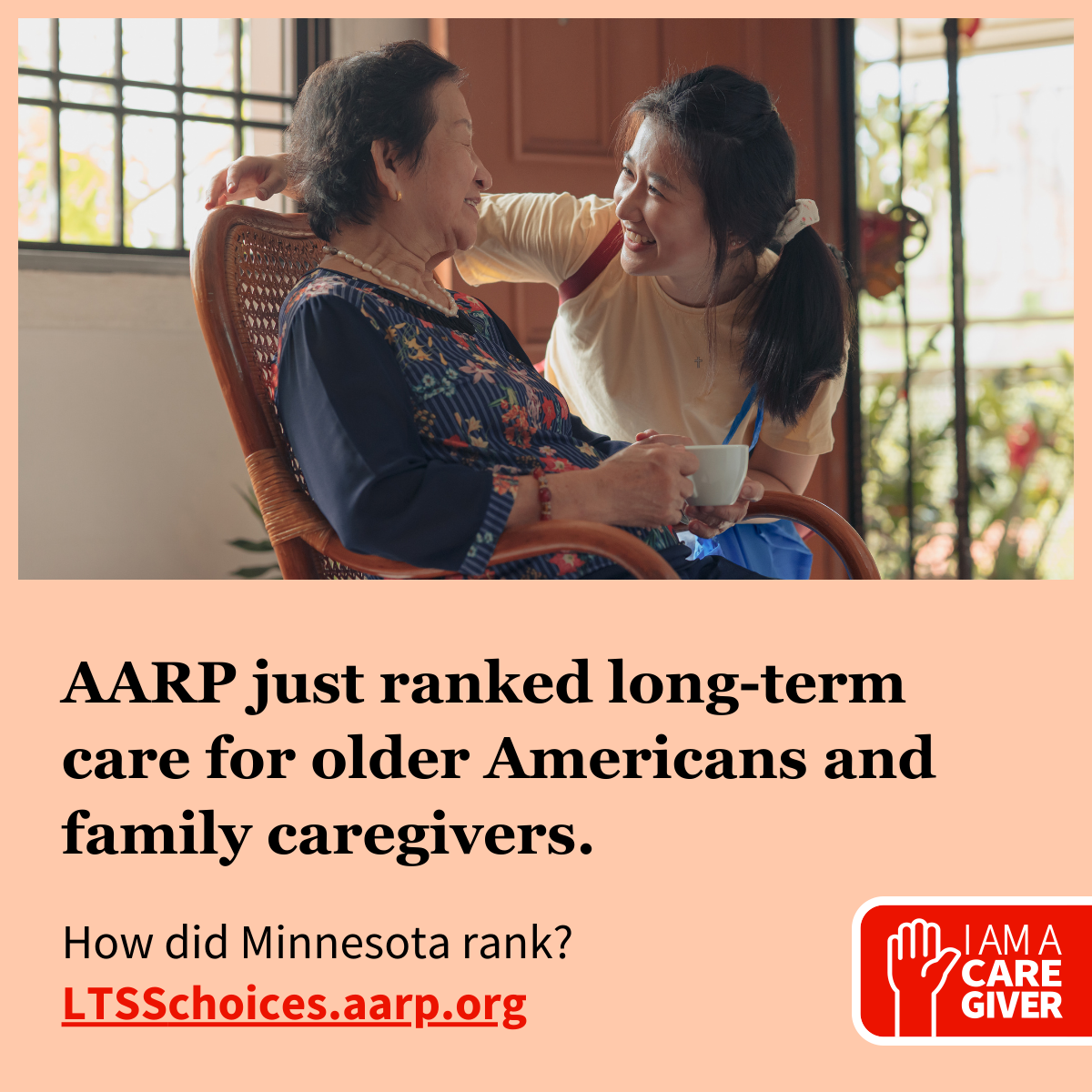AARP Hearing Center

AARP’s new Long-Term Services and Supports (LTSS) Scorecard finds that Minnesota ranks #1 and outperformed all other states in the country, particularly due to strong support for family caregivers, and providing many options in terms of services and long-term care settings. Ranking first in the nation indicates that Minnesota has made critical investments in home and community-based services and has a strong network of community-based providers focused on serving older Minnesotans in their homes.
However, the report shows there is still more to be done to keep up with the rapidly changing needs of an aging population. Minnesota ranked 40th in the percentage of nursing home residents with low care needs. Data from AARP’s Home and Community Preferences Survey shows that 77 percent of adults 50 and older want to remain in their homes for the long term — a number that has been consistent for more than a decade.
The pandemic reinforced the need to strengthen long-term care for countless loved ones across the country, including in Minnesota.
“The pandemic reinforced the need to strengthen long-term care for countless loved ones across the country, including in Minnesota,” said Cathy McLeer, State Director of AARP Minnesota. “To help older Minnesotans live in their homes and communities, AARP Minnesota wants to make presumptive eligibility permanent, allowing people to receive care in their home after being in the hospital rather than having to be admitted to a nursing home while their eligibility for Medicaid payments is being determined.”

During the pandemic, presumptive eligibility was temporarily implemented to avoid unnecessary admissions to nursing homes, where the spread of the virus was devastating to older Minnesotans. Last year, AARP Minnesota worked with the Minnesota legislature to pass a study exploring the feasibility of permanently implementing presumptive eligibility.
AARP’s Scorecard shows that there are many roads to meet the needs of all Minnesotans who deserve the very best care, including the 530,000 family caregivers in our state. AARP is pleased with the Legislature’s historic investments in the long-term care workforce and the passage of Paid Family & Medical Leave and expansion of the Live Well at Home Grants last year. Together, these policies ensure that more Minnesotans can live independently in their homes and communities. Minnesota is also developing a Multi-Sector Plan for Aging, through the work of the Governor’s Council on Age-Friendly Minnesota.
“COVID-19 tested our long-term care systems, and they failed. Now is the time to take the lessons we’ve learned to fix them for the sake of saving lives,” said Susan Reinhard, Senior Vice President, of ARP Public Policy Institute. “AARP’s LTSS Scorecard shows some progress and innovation, but there’s still a long way to go before we have systems that allow people to age well and independently for as long as possible and support the nation’s 48 million family caregivers. It’s also clear some emerging issues deserve more attention – from whether nursing homes are prepared to confront natural disasters, to whether they have plans in place to maintain and grow their workforces.”
The Scorecard includes a series of 50 indicators focused on 1) affordability and access, 2) choice of setting and provider, 3) safety and quality, 4) support for family caregivers, and 5) community integration, using data from a variety of publicly available sources, such as the Centers for Medicaid and Medicare Services, American Community Survey, and Bureau of Labor Statistics.
The LTSS Scorecard is funded by AARP Foundation with the support of The SCAN Foundation, The Commonwealth Fund, and The John A. Hartford Foundation and has been updated every three years since 2011.
"Every person, regardless of where they live, their race, or their socioeconomic background, deserves long-term care that is accessible, safe, and prioritizes what matters most to them,” said Terry Fulmer, PhD, RN, FAAN, president of The John A. Hartford Foundation. “The Scorecard shows that there are significant regional and racial disparities in the care a person receives. State policymakers can and should take steps now to close the gap in access to quality care.”
"The LTSS Scorecard indicates progress in some state programs, but opportunities exist for both public and private sectors to enhance LTSS,” said Sarita A. Mohanty, MD, President and Chief Executive Officer of The SCAN Foundation. “Most older adults prefer home and community-based care that meets their needs, but it remains financially out of reach for many working-class families, particularly those who are part of the 'forgotten middle'. TSF is committed to identifying, highlighting, and elevating innovative policies and programs to ensure all older adults can age well in home and community."
“Equity is an essential component of high-quality health care, and is especially important in LTSS,” said Melinda Abrams, Executive Vice President, Programs, The Commonwealth Fund. “I am thrilled AARP was able to add race and ethnicity data for several indicators. This year and going forward, this new data will shed light on the experiences people of color in LTSS and draw attention to individuals with the greatest need.”
To view the full Scorecard and state-by-state information visit ltsschoices.aarp.org.
































































